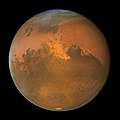پرونده:2005-1103mars-full.jpg

اندازهٔ این پیشنمایش: ۶۰۰ × ۶۰۰ پیکسل. کیفیتهای دیگر: ۲۴۰ × ۲۴۰ پیکسل | ۴۸۰ × ۴۸۰ پیکسل.
پروندهٔ اصلی (۸۰۰ × ۸۰۰ پیکسل، اندازهٔ پرونده: ۲۳۲ کیلوبایت، نوع MIME پرونده: image/jpeg)
تاریخچهٔ پرونده
روی تاریخ/زمانها کلیک کنید تا نسخهٔ مربوط به آن هنگام را ببینید.
| تاریخ/زمان | بندانگشتی | ابعاد | کاربر | توضیح | |
|---|---|---|---|---|---|
| کنونی | ۱۹ ژوئن ۲۰۰۹، ساعت ۱۶:۵۲ |  | ۸۰۰ در ۸۰۰ (۲۳۲ کیلوبایت) | Tryphon | Higher resolution. |
| ۱ ژانویهٔ ۲۰۰۶، ساعت ۰۱:۲۱ |  | ۷۰۰ در ۷۰۰ (۳۴ کیلوبایت) | Pringles | NASA's Hubble Space Telescope snapped this picture of Mars on October 28, within a day of its closest approach to Earth on the night of October 29. Hubble astronomers were also excited to have captured a regional dust storm on Mars that has been growing |
کاربرد پرونده
صفحهٔ زیر از این تصویر استفاده میکند:
کاربرد سراسری پرونده
ویکیهای دیگر زیر از این پرونده استفاده میکنند:
- کاربرد در af.wikipedia.org
- کاربرد در beta.wikiversity.org
- کاربرد در bg.wikipedia.org
- کاربرد در ca.wikipedia.org
- کاربرد در el.wikipedia.org
- کاربرد در en.wikipedia.org
- کاربرد در en.wikiquote.org
- کاربرد در en.wikiversity.org
- User:Marshallsumter/Radiation astronomy1/Planets/Sciences
- User:Marshallsumter/Radiation astronomy2/Reds
- User:Marshallsumter/Radiation astronomy/Chemistry
- User:Marshallsumter/Radiation astronomy1/History
- Solar System, technical/Classical planets
- User:Marshallsumter/Keynote lectures (draft)/Meteor radiation astronomy
- User:Marshallsumter/Radiation astronomy1/Planets/Classicals
- Draft:Original research/Planets
- User:Marshallsumter/Radiation astronomy2/Visuals/Quiz
- User:Marshallsumter/Rocks/Rocky objects/Astronomy
- User:Marshallsumter/Radiation astronomy/Courses/Principles/Hourly 2
- User:Marshallsumter/Radiation astronomy/Courses/Principles/Midterm quiz
- User:Marshallsumter/Radiation astronomy/Courses/Principles/Final quiz
- Titan/Quiz
- User:Marshallsumter/Rocks/Rocky objects
- Draft:Enceladus/Quiz
- Moon/Quiz
- Stars/Sun/Heliology/Quiz
- Earth/Quiz
- User:Marshallsumter/Radiation astronomy/Clouds
- User:Marshallsumter/Radiation astronomy/Cryometeors
- User:Marshallsumter/Radiation astronomy1/Lithometeors
- Stars/Reds/Quiz
- Draft:Dione/Quiz
- User:Marshallsumter/Radiation astronomy2/Scattered disks/Quiz
- User:Marshallsumter/Radiation astronomy1/Kuiper belts/Quiz
- WikiJournal Preprints/Cryometeors
- کاربرد در es.wikipedia.org
- کاربرد در fr.wikipedia.org
- کاربرد در fr.wikinews.org
- کاربرد در gn.wikipedia.org
- کاربرد در hi.wikipedia.org
- کاربرد در hu.wikipedia.org
نمایش استفادههای سراسری از این پرونده.
